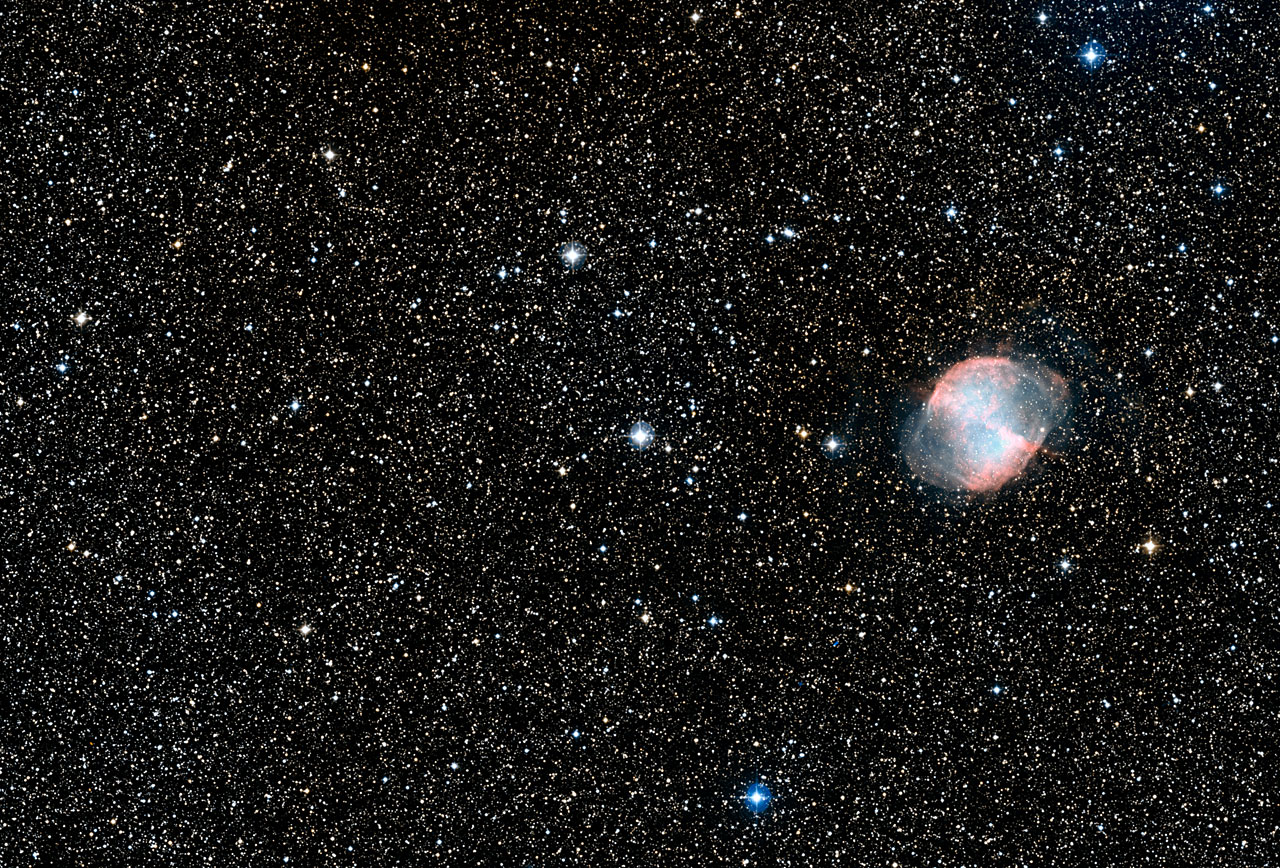The Hubble Space Telescope caught the whole thing during two periods in early 2010 and late 2011 as it was silhouetted against its parent star - known as the the transit method of observation (see Planet Hunters - How They Do It for various ways planet discoveries and observations are made). While backlit in this way, HD 189733b’s atmosphere 'imprinted' its chemical signature on the starlight, allowing astronomers to decode what was happening on scales that are too tiny to image directly.
HD 189733b has a blue sky like our planet, though that’s where the similarities with Earth stop. It is a huge gas giant similar to Jupiter, but lies extremely close to its star, just one thirtieth the distance of the Earth to the Sun. HD 189733A is slightly smaller and cooler than the Sun but that is still an extremely hot climate, above 1000 degrees Celsius, and the upper atmosphere is battered by energetic extreme-ultraviolet and X-ray radiation. It orbits every 53 hours.

CLICK FOR LARGER SIZE. Star field image showing the star HD 189733 in the center. To the right of the star is planetary nebula Messier 27. The field-of-view is approximately 0.9 x 0.6 degrees. Credit: NASA, ESA, and the Digitized Sky Survey 2. Acknowledgment: Davide De Martin (ESA/Hubble)
“The first set of observations were actually disappointing,” said astronomer Alain Lecavelier des Etangs, “since they showed no trace of the planet’s atmosphere at all. We only realised we had chanced upon something more interesting when the second set of observations came in.”
The team’s follow-up observations, made in 2011, showed a dramatic change, with clear signs of a plume of gas being blown from the planet at a rate of at least 1000 tonnes per second. “We hadn’t just confirmed that some planets’ atmospheres evaporate,” Lecavelier explains, “we had watched the physical conditions in the evaporating atmosphere vary over time. Nobody had done that before.”
Why the change?
Despite the extreme temperature of the planet, the atmosphere is not hot enough to evaporate at the rate seen in 2011. Instead the evaporation is thought to be driven by the intense X-ray and extreme-ultraviolet radiation from the parent star, HD 189733A, which is about 20 times more powerful than that of our own Sun. Taking into account also that HD 189733b is a giant planet very close to its star, then it must suffer an X-ray dose 3 million times higher than the Earth.
Evidence to support X-ray driven evaporation comes from simultaneous observations of HD 189733A with the Swift satellite which, unlike Hubble, can observe the star’s atmosphere-frying X-rays. A few hours before Hubble observed the planet for the second time, Swift recorded a powerful flash of radiation coming from the surface of the star, in which the star briefly became 4 times brighter in X-rays.
“X-ray emissions are a small part of the star’s total output, but it is the part that it is energetic enough to drive the evaporation of the atmosphere,” explains Peter Wheatley from the University of Warwick and one of the co-authors of the study. “This was the brightest X-ray flare from HD 189733A of several observed to date, and it seems very likely that the impact of this flare on the planet drove the evaporation seen a few hours later with Hubble.”
X-rays are energetic enough to heat the gas in the upper atmosphere to tens of thousands of degrees, hot enough to escape the gravitational pull of the giant planet. A similar process occurs, albeit less dramatically, when a space weather event such as a solar flare hits the Earth’s ionosphere, disrupting communications. While the team believes that the flash of X-rays is the most likely cause of the atmospheric changes they saw on HD 189733b, there are other possible explanations. For example, it may be that the baseline level of X-ray emission from the star increased between 2010 and 2011, in a seasonal process similar to the Sun’s 11-year sunspot cycle.
Regardless of the details of exactly what happened to HD 189733b’s atmosphere, which the team hope to clarify using future observations with Hubble and ESA’s XMM-Newton X-ray space telescope, there is no question that the planet was hit by a stellar flare, and no question that the rate of evaporation of the planet’s atmosphere shot up.
This research has relevance not only for the study of Jupiter-like planets. Several recent discoveries of rocky “super Earths”, like Kepler-10b and CoRoT-7b, near their parent stars are thought to be the remnants of planets like HD 189733b, after the complete evaporation of their atmospheres.
“Temporal variations in the evaporating atmosphere of the exoplanet HD189733b” will be published in a forthcoming issue of Astronomy and Astrophysics.






Comments